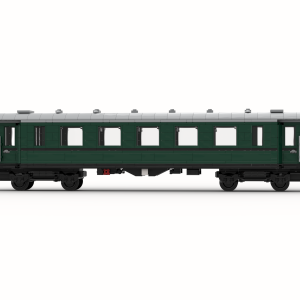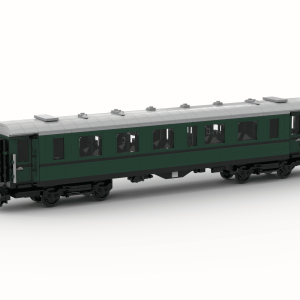Eilzugwagen (1930) 2nd Class Passenger Coach (8w)
NO PHYSICAL BRICKS, ONLY DOWNLOADABLE CONTENT
With the purchase of this object you only purchase downloadable PDF instructions and Parts List
5,00 €
Information about the original:
After the construction and testing of a large number of experimental coaches in 1928 and 1929, which were primarily intended to find the most practical interior design, series production of express train coaches began in 1930.The design was in riveted construction in accordance with the construction principles valid at the time. All coaches had large compartments with a central gangway, with 1+3 seating arrangement in the second class and 2+3 seating arrangement in the third class. The entrances were recessed as on the period type 28 express coaches, but the roof was rounded like a basket arch at the end of the coach as on the Rheingold coaches. The entrances at the ends of the third class carriages were designed with double doors to speed up the entry and exit of passengers. At the ends of the second class carriages there was a single banging door, which was considered sufficient because of the lower passenger frequency. There was a toilet with washing facilities adjacent to each boarding area. From 1930 onwards, luggage carriages were also purchased to match the seat carriages.Information about the moc:
This passenger coach is designed in 8 studs wide and has a length of 59 studs and a height of 13 studs. I tried to build the coach as close as possible to the original, so at each end of the wagon are single doors and toilets are at the end of the wagon. The passage between the seats is in the middle of the train.
After the construction and testing of a large number of experimental coaches in 1928 and 1929, which were primarily intended to find the most practical interior design, series production of express train coaches began in 1930.The design was in riveted construction in accordance with the construction principles valid at the time. All coaches had large compartments with a central gangway, with 1+3 seating arrangement in the second class and 2+3 seating arrangement in the third class. The entrances were recessed as on the period type 28 express coaches, but the roof was rounded like a basket arch at the end of the coach as on the Rheingold coaches. The entrances at the ends of the third class carriages were designed with double doors to speed up the entry and exit of passengers. At the ends of the second class carriages there was a single banging door, which was considered sufficient because of the lower passenger frequency. There was a toilet with washing facilities adjacent to each boarding area. From 1930 onwards, luggage carriages were also purchased to match the seat carriages.Information about the moc:
This passenger coach is designed in 8 studs wide and has a length of 59 studs and a height of 13 studs. I tried to build the coach as close as possible to the original, so at each end of the wagon are single doors and toilets are at the end of the wagon. The passage between the seats is in the middle of the train.

















There are no reviews yet.